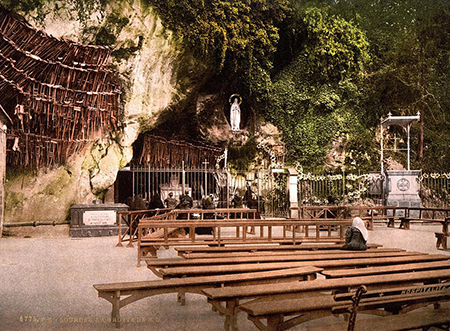lourdes
Saturday, February 11, 2017
pilgrimage as economy
 To those of us from certain parts of Calabria, today is a major holy-day – the feast of Our Lady of Lourdes.
To those of us from certain parts of Calabria, today is a major holy-day – the feast of Our Lady of Lourdes.
Even today, throughout southern Italy there are shrines to Our Lady of Lourdes. In many small towns, in Calabria, in Basilicata, in Puglia you can still see posters advertising pilgrimages to Lourdes. Devotion to Our Lady of Lourdes is still wide-spread. Many of my relatives in Aprigliano have made the pilgrimage to Lourdes, some more than once.
This date and this holy-day were important religious events of my early life. When we came to Canada, I had all sorts of memorabilia for Our Lady of Lourdes. My dad, who did a 3-month work-stint in south-western France, went to Lourdes and brought back most of the paraphernalia we had in Sault Ste Marie.
But age and some ability to connect dots previously isolated by cultural myths, allows me to look at the past through a different lens. What I’m finally realizing is the economic and PR machinery that promoted the pilgrimage to south-western France. An industry that got poor peasants from Italy’s poorest regions to travel to south-western France. A 2,000 kilometers or 1200 miles bus ride. And imagine all the people and businesses, along the 1200-mile route, that made money off the pilgrims. And imagine all the restaurants, all the hotels, all the souvenir shops in Lourdes that profited from the pilgrims from southern Italy.
When we were in San Giovanni Rotondo, in Puglia, it was clear that the town was totally dependent on its Santuario Padre Pio for its economic livelihood. (Padre Pio is southern Italy’s own saint and his burial place in San Giovanni Rotondo is a huge pilgrimage site.) Assisi is the prototype Italian pilgrimage town. The whole town is a religious tourist destination. The old medieval town has been cleaned up and refurbished; all the buildings are pointed with new grout, all the walls – houses, palaces, churches – are clean; there are beautiful medieval street lamps throughout; and all the hotels, the restaurants cater to the religious tourists.
Thinking about the economy of pilgrimages, led me to realize that my dad and his friends didn’t end up working in south-western France by accident. I’ll bet that the same people who organized the bus-trips from Aprigliano to Lourdes, over the years, got to know the small business owners – in this case the forestland-owners – in south-western France and when those business owners needed migrant workers to prune and cut trees, the pilgrimage organizers recruited in Aprigliano. How different can recruiting to fill a bus or a small hotel be from recruiting workers who can chop down trees? In post-war Calabria men transitioning from a farm economy to an urban economy were a dime a dozen. Transportation and lodgings options were already in place, so what that the people going over were going to work rather than pray.
What gets revealed in this new awareness is the religious veneer – the patina that covers the economic engine of moving people from one location to another.
The above image is an old postcard of the grotto at the shrine in Lourdes. Note the hundreds of crutches hanging on the wall and from the ceiling in the cave.